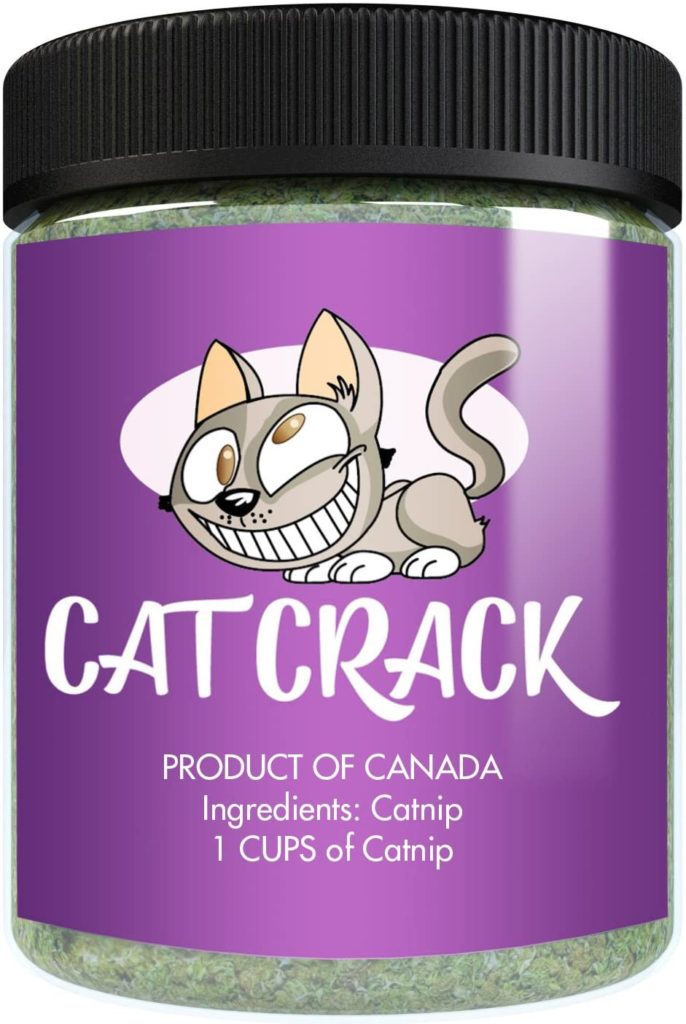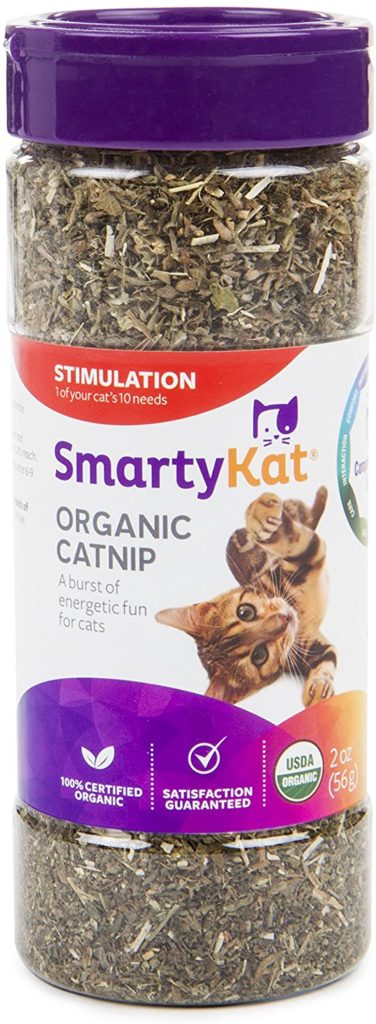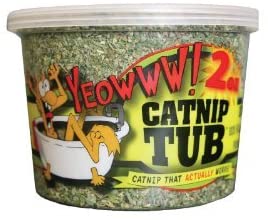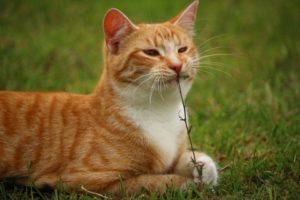If you own a cat, you know catnip shows up EVERYWHERE. It’s tucked into your kitty’s toys, comes in packets with cardboard scratchers, flavors their treats, and inhabits many garden beds as a weed. The pet industry automatically associates cats and catnip. But what if you want the real thing? After all, toys lose their potency. And, eventually, you need to toss out those cardboard scratchers. Where do you find the best catnip for cats? It’s not quite as easy as stepping outside and pulling off a few leaves.
Forms of Catnip
These days, catnip crops up in every form you could imagine:
- Fresh herb
- Dried leaves
- Sprays (made from concentrated oils)
- Bubbles (which also contain the oils)
- Toys stuffed with dried leaves
- Cat “wine” (there’s no alcohol involved – just a mixture brewed from the dried leaves)
The variety sounds exciting and tempting, but there are drawbacks. The oils used in catnip sprays and bubbles lack the potency of the original leaves. Your cat may enjoy some of the effects of the catnip, but the nepetalactone isn’t as strong. And odds are you’re not going to pour cat wine on the furniture. It’s effective for calming your cat (mind the amount you offer), but you won’t see any silly behaviors.
If you want the typical “happy” response, you need to focus on the leaves and flowers. And unless you’re growing the plant yourself, you’ll need the dried leaves.
Uses for the Best Catnips
Obviously, you can sprinkle the leaves on the floor and watch your cat dance and roll around. But catnip has other beneficial uses. The nepetalactone communicates a message of joy to your cat’s brain. Even if your kitty doesn’t turn into a goofball, the calming communication usually goes through. That’s a helpful neural pathway you can work with.
Training with Catnip
Catnip’s effects only last for ten minutes. Then your cat needs a “reset” period of at least thirty minutes. In general, when you’re training your cat, you want to stick to a period of 10-15 minutes. How convenient!
The best catnips for cats make excellent desensitization rewards when you’re working on getting your cat into their carrier. Sprinkle the dried leaves inside and allow your cat to investigate. They’ll learn to associate the carrier with a positive sensation – as opposed to a frightening experience.
If your kiddo’s prone to scratching the furniture, dust their cardboard scratcher or scratching post with catnip. You’ll draw their attention to it. It’s a positive alternative to cat deterrents.
Introductions with Catnip
Moving into a new home is stressful for everyone. Your cat needs to learn new sights, new scents, and new sounds. Adding a sprinkling of catnip where you anticipate they’ll spend most of their time can aid the transition. They’ll get a calming euphoria. You also reassure them that the new home’s safe.
When you bring new cats into the household, catnip can help serve as an icebreaker. You’ll still need to observe proper introduction protocol, but when everyone’s feeling mellow? It makes things easier.
Choosing the Best Catnip
Catnip is catnip, right? It seems like one plant should be the same as another. However, catnip isn’t always grown under the same conditions. You want to protect your cat from potential contaminants. And if you want your kitty to get the most enjoyment from their catnip, you need to consider several variables.
- Organic: As you might expect, organic catnip costs more. However, when you see that official seal, you know your cat will not end up exposed to pesticides, preservatives, or additives. You DON’T want chemicals on the catnip.
- Freshness: Though dried, the best catnips lose potency over time. Within one year, the nepetalactone ceases to have an effect. Check the date on the container.
- Packaging: Oxygen exposure impacts potency. You want a resealable container to prevent your catnip from “wearing out.” If you have to transfer it to a different container, that’s a pain.
- Quantity: Everyone loves buying in bulk to save on cost. However, the best catnips come in smaller amounts. You don’t want to overdo it every day for your kitty – you’ll make them sick. And if you have TOO MUCH, it’ll lose potency.
- Quality: What’s in the container? Some companies fill their containers with leaves AND stems. The stems don’t have as much nepetalactone, and they’re SHARP. You want a catnip with more leaves and flowers.
Growing Your Own Catnip
If you’d rather skip the shopping process, you CAN grow catnip yourself. It’s not difficult. (The difficult part is wrangling the plant once it’s established)
All you need to do is break a leaf to release the oils. Your cat will roll around in kitty bliss. Fresh IS the best!
If you want to dry the leaves, you can hang them upside down. Some people use a fan to decrease the drying time. Your cat should leave them alone unless you happen to damage one of the flowers or leaves – that’s how you release the oils. Store the dried leaves in an air-tight container. (REALLY air-tight!)
The Best Catnips for Cats
Catnip works in many situations – not just for entertainment (for you and your cat). You can keep it on-hand for playtime OR for those small doses when your feline needs some downtime. Always check with your veterinarian on dosing to prevent potential health problems.
If you’re nervous about venturing into using one of the best catnips, take baby steps. Pop one of your cat’s toys into a sealed bag with the catnip and leave it overnight. The toy will absorb the scent. And when you sprinkle catnip into a cardboard scratcher, the dried herb drops between the folds where your cat won’t reach. They’re safe options, but your kitty still enjoys the benefits.
Cat Crack plays up the joke of kitties getting “high” on catnip. The organic herbs come from Canada, reassuring you your kiddo won’t get any artificial ingredients or chemicals (they only have one ingredient, actually). They’re careful to cultivate the herb during the optimal growing season, so you’re cat only gets a resealable container of leaves and flowers – no stems.
Downsides? Some people get confused over the sizing (not quite sure why – it says “1 cup” clearly on the jar). However, considering the small size, it’s pricey, especially when you factor in the shipping.
The Good
- Organic
- Only includes flowers and stems
- Resealable container
The Bad
- Expensive
- Some confusion on sizing of jar
Most people are familiar with the KONG brand. Their all-natural catnip gets harvested during the peak flowering season. Then they dry it out in the fields. They only use plants from North America, and they pride themselves on utilizing renewable resources. (Though, honestly, catnip IS considered a weed by most plant-inclined people) You also get a cat toy you can stuff the catnip into, as a fun bonus.
The downsides? The tin isn’t the most air-tight of seals. So the catnip WILL lose some potency. Also, some stems make it into the mix, which can pose a problem to your cat – especially if they eat the catnip.
The Good
- All-Natural
- Utilizes renewable resources
- Includes a catnip toy
The Bad
- Tin not air-tight
- Mixture includes sharp stem pieces
If you want to spring for different sizes, OurPets is the best catnip option. You get six different options, from a 0.5-ounce bag to a 4-ounce jar. That should cover every feline situation! The North American-grown, all-natural catnip gets packaged in Oregon, using the height of the growing season. They use air-tight packaging, whether you opt for the bags or the jars, so your catnip stays nice and potent. And you won’t break the budget, even with the 4-ounce container!
So what are the downsides? OurPets doesn’t allow returns on their catnip, which is always a frustration. Also, they include stems in their mix. Keep an eye on things if your cat tends to eat their catnip.
The Good
- All-Natural
- Multiple sizes available
- Resealable container
The Bad
- Mixture includes sharp stem pieces
- Returns not allowed
Pet Craft Supply Co. grows its catnip in the Pacific Northwest, avoiding chemicals, pesticides, and fillers. They make sure the herbs get harvested during the peak flowering season, so your cat enjoys the most potency possible. The resealable container preserves that potency, too, ensuring your cat gets the same happy experience time and time again.
Downsides? Once again, you need to keep an eye out for stems in the mix.
The Good
- All-Natural
- Resealable container
The Bad
- Mixture includes sharp stem pieces
If you want that organic label, SmartyKat is one of the best catnip options out there. Their blend of catnip carries the USDA Organic stamp of approval, certifying it’s free of potent chemicals, pesticides, and fillers. The resealable top includes a sprinkle cap, making it easy to shake or pour. You also have two other sizing options: a 0.5-ounce or 1-ounce pouch if you want smaller doses. SmartyKat has a safety philosophy, so they make sure your kitty won’t get injured with any of their products.
The downsides? As expected, you need to pay a little more for that organic label. Also, some people feel the catnip isn’t as potent as it was in past years. You may want to start with the smaller packages and then move up depending on how your cat reacts.
The Good
- Organic
- Only includes flowers and leaves
- Multiple sizes available
- Resealable container
The Bad
- Expensive
- May not be as potent as in past batches
No one wants to worry about potentially sharp stems. Yeoww! understands, and they’re careful to sort the stems out, making them one of the best catnips for cats. Plus, they’re organic! You can choose from a 1-ounce or 2-ounce bag that sits within a resealable tub. And with that organic promise, you’re not going to worry about chemicals or pesticides.
So what are the downsides? While the tub’s resealable, the bags aren’t. And cats have no problem getting into the bags. (Trust me on this one – cats get into plastic bags when catnip’s involved) You’ll want to use a different option to keep the catnip fresh. And, again, you’ll need to spend a little more.
The Good
- Organic
- Only includes flowers and leaves
- Multiple sizes available
The Bad
- Expensive
- Bags don't reseal
- Easy for cats to open bags
A Bit of Nip
Our cats deserve the best of everything – including catnip. But some of us lack a green thumb. (I’ve killed every plant I tried to take care of) So if growing your own herbs is out of the question, you need to shop around for the best catnip for cats. And with some careful research, they’re pretty easy to find.
Then your cat gets the benefits of that nepetalactone. Whether it turns them into a whirling dervish or a calm and composed sphinx, the brain’s relaxation is always beneficial. And if you combine it with your training habits, you get a double bonus.
So don’t despair over a wilting garden. There’s a catnip out there that’ll keep your kitty happy for months to come.












No comment yet, add your voice below!